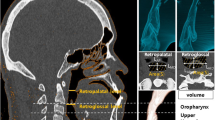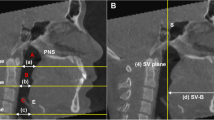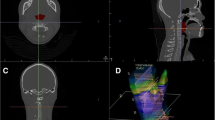Abstract
Background
To evaluate changes in airway dimensions following mandibular setback with conventional orthognathic approach (COA) and surgery-first orthognathic approach (SFOA).
Materials and Methods
Treatment records of 20 patients who underwent mandibular setback with SFOA/COA were divided into two groups (COA and SFOA, ten patients in each group). Acoustic pharyngometry values were obtained at T0 (01 week prior to surgery), T1 (01-month post-surgery) and T2 (01-year post-surgery). Percentage change in mean volume and area was obtained at T1 (T1–T0) to evaluate airway changes and at T2 (T2–T1) to compare relapse of airway changes in both groups. Changes in airway per mm setback at T1 (T1–T0) and T2 (T2–T1) were also obtained in both groups.
Results
For both parameters, SFOA showed greater reduction at T1 and greater relapse at T2 as compared to COA. The reduction in airway volume at T1 was 0.56 mm/mm setback in COA compared to 1.06 mm/mm setback in SFOA (P-value > 0.05). The relapse in airway volume at T2 was 0.15 mm/mm setback in COA compared to 0.25 mm/mm setback in SFOA (P-value > 0.05). The reduction in area at T1 was 0.062 mm/mm setback in COA compared to 0.110 mm/mm setback in SFOA (P-value > 0.05). The relapse in area at T2 was 0.016 mm/mm setback in COA compared to 0.034/mm setback in SFOA (P-value < 0.05).
Conclusion
In setback cases, SFOA has greater airway reduction immediate post-surgically and greater relapse at 01-year follow-up. Predicting these changes at diagnostic and treatment planning stage may prevent potential adverse events on airway.




Similar content being viewed by others
References
Tan SK, Leung WK, Tang TH, Zwahlen RA (2017) Effects of one or two jaw osteotomies on pharyngeal airways: overview of systematic reviews. Int J Oral Maxillofac Surg 46(1):168–178
Hasebe D, Kobayashi T, Hasegawa M et al (2011) Changes in oropharyngeal airway and respiratory function during sleep after orthognathic surgery in patients with mandibular prognathism. Int J Oral Maxillofac Surg 40:584–592
Zayer MA, Leung YY (2017) Skeletal and airway stability after mandibular setback in patients with mandibular prognathism: a systematic review. Int J Oral Maxillofac Surg 46(1):152–159
Holty JC, Guilleminault C (2010) Maxillomandibular advancement for the treatment of obstructive sleep apnea: a systematic review and meta-analysis. Sleep Med Rev 14:287–297
Li KK, Powell NB, Riley RW, Troell RJ, Guilleminault C (2000) Long-term results of maxillomandibular advancement surgery. Sleep Breath 4(3):137–139
Baek S, Ahn HW, Kwon YH, Choi JY (2010) Surgery-first approach in skeletal class III malocclusion treated with 2-jaw surgery: evaluation of surgical movement and postoperative orthodontic treatment. J Craniofac Surg 21:332–338
Liou EJ, Chen PH, Wang YC, Yu CC, Huang CS, Chen YR (2011) Surgery-first accelerated orthognathic surgery: postoperative rapid orthodontic tooth movement. J Oral Maxillofac Surg 69(3):781–785
Nagasaka H, Sugawara J, Kawamura H, Nanda R (2009) “Surgery first” skeletal class III correction using the skeletal anchorage system. J Clin Orthod 43(2):97–105
Kim CS, Lee SC, Kyung HM, Park HS, Kwon TG (2014) Stability of mandibular setback surgery with and without presurgical orthodontics. J Oral Maxillofac Surg 72:779–787
Choi JW, Park YJ, Lee CY (2015) Posterior pharyngeal airway in clockwise rotation of maxillomandibular complex using surgery-first orthognathic approach. Plast Reconstr Surg Glob Open 3:485–492
Chen F, Terada K, Hua Y, Saito I (2007) Effects of bimaxillary surgery and mandibular setback surgery on pharyngeal airway measurements in patients with class III skeletal deformities. Am J Orthod Dentofac Orthop 131:372–377
Tselnik M, Pogrel MA (2000) Assessment of the pharyngeal airway space after mandibular setback surgery. J Oral Maxillofac Surg 58:282–285
Hochban W, Schurmann R, Brandenburg U, Conradt R (1996) Mandibular setback for surgical correction of mandibular hyperplasic-does it provoke sleep disorder? Int J Oral Maxillofac Surg 25:333–338
Liukkonen M, Vahatalo K, Peltomaki T, Tiekso J, Happonen RP (2002) Effect of mandibular setback surgery on the posterior airway size. Int J Adult Orthod Orthognath Surg 17:41–46
Nakagawa F, Ono T, Ishiwata Y, Kuroda T (1998) Morphologic changes in the upper airway structure following surgical correction of mandibular prognathisn. Int J Adult Orthod Orthognath Surg 13:299–306
Jackson AC, Butler JP, Millet EJ, Hoppin FG Jr, Dawson SV (1977) Airway geometry by analysis of acoustic pulse response measurements. J Appl Physiol 43:523–536
Tsolakis IA, Venkat D, Hans MG, Alonso AA, Palomo JM (2016) When static meets dynamic: comparing cone-beam computed tomography and acoustic reflection for upper airway analysis. Am J Orthod Dentofac Orthop 150:643–650
Deyoung PN, Bakker JP, Sands SA, Batool-Anwar S, Connolly JG, Butler JP et al (2013) Acoustic pharyngometry measurement of minimal cross-sectional airway is a significant independent predictor of moderate to severe obstructive sleep apnea. J Clin Sleep Med 9:1161–1164
Maria A, Guijjaro P, Guijjaro R, Alfaro AH (2016) Surgery first in orthognathic surgery: a systematic review of the literature. Am J Orthod Dentofac Orthop 149(4):448–462
Author information
Authors and Affiliations
Corresponding author
Ethics declarations
Conflict of interest
The authors declare that they have no competing interests.
Ethical Standard
The study design was approved by the Institutional Ethical Committee.
Additional information
Publisher's Note
Springer Nature remains neutral with regard to jurisdictional claims in published maps and institutional affiliations.
Rights and permissions
About this article
Cite this article
Agarwal, S.S., Datana, S., Sahoo, N.K. et al. Evaluation of Airway Dimensions Following Mandibular Setback with Surgery-First Orthognathic Versus Conventional Orthognathic Approach. J. Maxillofac. Oral Surg. 20, 296–303 (2021). https://doi.org/10.1007/s12663-020-01379-y
Received:
Accepted:
Published:
Issue Date:
DOI: https://doi.org/10.1007/s12663-020-01379-y




